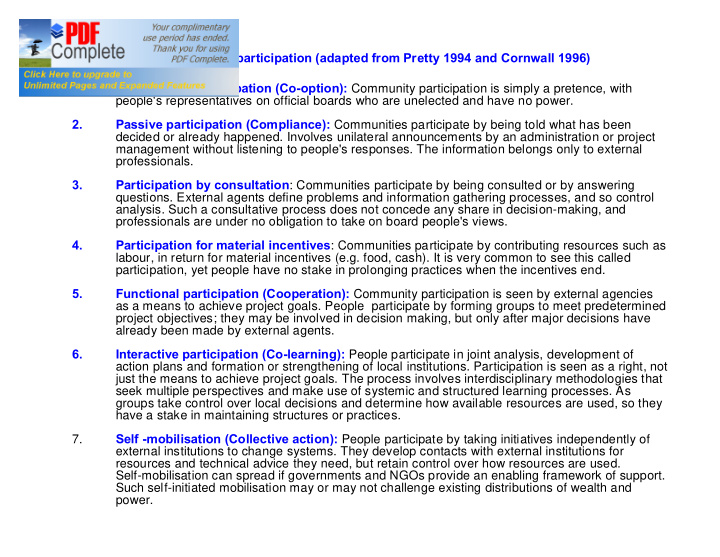



Seven types of community participation (adapted from Pretty 1994 and Cornwall 1996) 1. Manipulative participation (Co-option): Community participation is simply a pretence, with people's representatives on official boards who are unelected and have no power. 2. Passive participation (Compliance): Communities participate by being told what has been decided or already happened. Involves unilateral announcements by an administration or project management without listening to people's responses. The information belongs only to external professionals. 3. Participation by consultation : Communities participate by being consulted or by answering questions. External agents define problems and information gathering processes, and so control analysis. Such a consultative process does not concede any share in decision-making, and professionals are under no obligation to take on board people's views. 4. Participation for material incentives : Communities participate by contributing resources such as labour, in return for material incentives (e.g. food, cash). It is very common to see this called participation, yet people have no stake in prolonging practices when the incentives end. 5. Functional participation (Cooperation): Community participation is seen by external agencies as a means to achieve project goals. People participate by forming groups to meet predetermined project objectives; they may be involved in decision making, but only after major decisions have already been made by external agents. 6. Interactive participation (Co-learning): People participate in joint analysis, development of action plans and formation or strengthening of local institutions. Participation is seen as a right, not just the means to achieve project goals. The process involves interdisciplinary methodologies that seek multiple perspectives and make use of systemic and structured learning processes. As groups take control over local decisions and determine how available resources are used, so they have a stake in maintaining structures or practices. Self -mobilisation (Collective action): People participate by taking initiatives independently of 7. external institutions to change systems. They develop contacts with external institutions for resources and technical advice they need, but retain control over how resources are used. Self-mobilisation can spread if governments and NGOs provide an enabling framework of support. Such self-initiated mobilisation may or may not challenge existing distributions of wealth and power.
Community participation � Active involvement in all stages � Self mobilization � Shared decision-making � Contribution of resources � Ownership � Right to participate (rights-based approach)
Where are we? Need assessment Evaluation Design & planning Project Cycle Monitoring Implementation
Participatory Impact Assessment (PIA) � Local people are capable of conducting their own problem analysis �� top down � approach vs. local ownership, control and capacity building � Development workers as facilitators
� Local people are capable of identifying and measuring their own indicators of change � A tool for strengthening the management of local organizations � Uses adaptation of participatory methods to assess changes over time and project attribution � Looks at real impact on people, not simply a measure of project implementation
� Locally-defined impact indicators are crucial; indicators often comprise both quantitative and qualitative indicators � Example of quantitative indicators: � Milk consumption � Income from sale of grain � Access to market � Example of qualitative impact indicators: � Trust, Confidence, Hope, Status
A systematic, well-designed participatory impact assessment can: � Assist communities and CBOs to measure changes using their own indicators and their own methods = local capacity-building; empowerment � Provide aid agencies (NGOs, donors etc) with previously hidden information on project impact � Overcome the weakness inherent in many NGO and donor monitoring and evaluation systems e.g � Over-emphasis on process not impact � Over-emphasis on anecdote, ad hoc interview and staff or consultant opinion These weakness limit the effectiveness of NGOs in policy forums � Contribute to a wider body of learning about the impact of development programs, bu providing data and information which can be presented and disseminated in diverse media, including scientif ic publications.
Recommend
More recommend